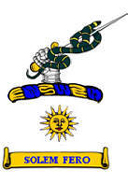|
PARIS
|
During the years
1836-1860, Mereweather recorded in a book of Memoranda
quotations in poetry and prose from various authors. He
also wrote down his own thoughts, poems and narratives.
In the summer
months of 1844, Mereweather visited Normandy and Paris.
The following notes, in diary form, cover pages 166-197.
Paragraph breaks have been inserted. Various
illustrations have been added. |
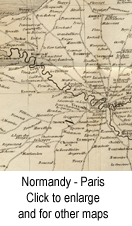 |
A Diary kept during a visit to
France in 1844
April 14th 1844. On board the James
Watt steamer plying twixt London and Havre. Very sick "the
pains of death got hold of me".
15th. Arrived in Havre
about noon. As we sailed up the quays, the perspective of the
various streets debouching towards the water very curious.
Aiken’s hotel, clean but expensive.
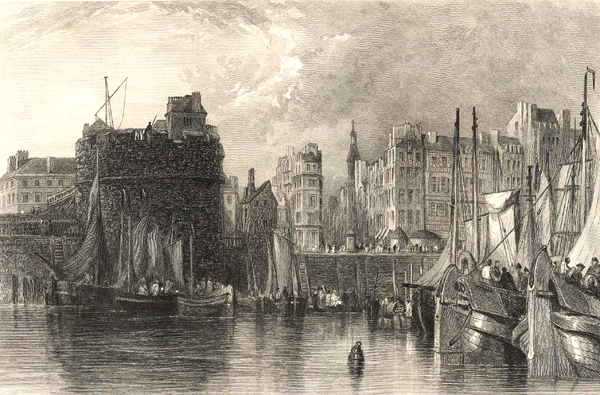
Le Havre de Grâce
Steel engraving by
W. Miller after a picture by C. Stanfield, published in
Stanfield's Coast Scenery, 1836
16th. Went to Caen
viâ Honfleur. A fine country in the first verdure of
spring.
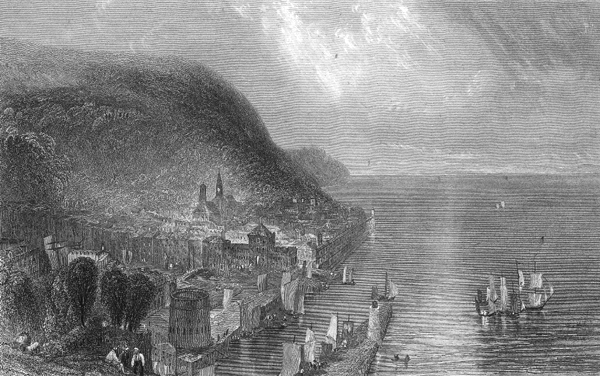
Honfleur, from Meyer's Universum,
c. 1839
17th. Went to Bayeux and back by the Diligence.
A quiet monastic looking town with a cathedral in advanced
Norman style. 2 painted windows, one very good, the
termination of choir circular, the Lady chapel plain, the nave
ornamented with rich pannelling. Exterior imposing, a centre
tower surmounted by a dome of later architecture but of very
good effect, moulding very good, canopies of niches very
elaborate, two fine porches; there is however in the interior
a gaudy marble screen of modern date separating the nave from
chancel which destroys much of the imposing effect of the
rest. I also observed a gay sarcophagus-shaped tomb of various
marbles as I supposed, but on nearer examination, it turned
out to be of wood.
Nearly all the early churches which
I have hitherto seen are impaired if not spoilt as to effect
by modern innovations: gaudy altar pieces, flimsy-looking
glories highly guilt, poor paintings though by no means
without exception, tawdrily framed looking glasses hung up on
each side of the altars, dirty virgins with still dirtier
babies in their arms, dressed out in satin robes begrimed with
dust and time, offend the eye, requiring something more in
keeping with the solemnity of a building erected by
masterminds of the 12th and 13th centuries.
18th.
Stayed in Caen and visited not a few churches. St Pierre is
the principal church. It is without transepts, superb flying
buttresses, the interior is very good, the nave and aisles are
free from pannelling but the Lady chapel and the two adjoining
chapels on each side have the richest ceilings that can be
imagined; they are loaded with fretwork and have long pendent
bosses like stalactites of 3 feet in length and elaborately
ornamented. This church may be considered of equal interest
with the Cathedral of Bayeux and is alone worthy of a visit to
Normandy.
St Sauveur is an old church. It is equally
divided by some arches running from W to E so that it seems to
have two naves. One of these arches is extraordinary for its
dimensions and boldness.
L’Abbaye St Etienne is a fine
building of the pure early Norman style built by William the
Conqueror about 1080. Its architecture is well worthy of
study, the style being very severe and comparatively
unornamented. What is introduced, however, by way of ornament
produces a great effect. The view from the nave into the
lantern of the centre tower is worthy of very great
admiration.
The church of St Jean contains exquisite
coping to the triforium gallery. The Lady chapel, in place of
the Virgin and Child, contains a group of stone statues
representing the Ascension. As a strong light is thrown on
this group from a concealed window above, the figures have a
good effect.
The church of Vaucelles has the exterior
of its N. transept shaped like a gable, very richly
ornamented.
The church of St Nicholas is very early in
the Romanesque style. The E. end is curious. It is now turned
into a shut house. In the Rue des Capuchins, there is an
extraordinary frontage to two attics in an old house of humble
appearance. This frontage is rich in ornament and contains
figures in relief as at Chester.
19th. Descended the
Orne (the Caen river) in a steamer. Passed several boats laden
with gravel. Aimed at the mouth, we steered NE and after a
rough passage of two hours entered the port of Havre. Wrote to
Ann.
20th. Ascended the Seine to Rouen in the steamer
La Normandie. There is so much fine scenery in this route as
to make it desirable to go thus to Paris. La Normandie was
honoured by being chosen to be the bearer of Napoleon’s
remains from Havre to Paris.
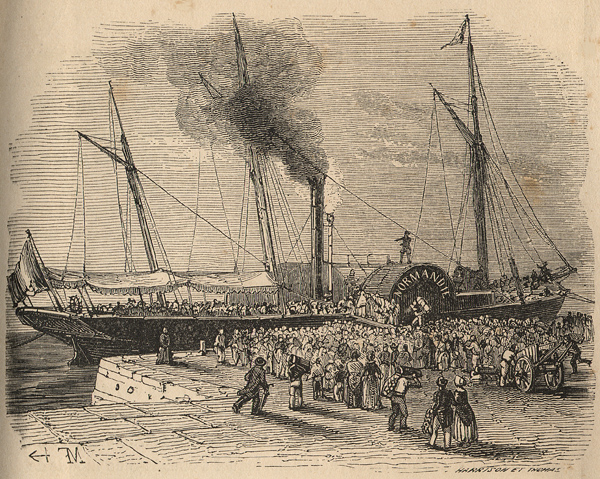
The steamer "La Normandie"
Drawing by
Antoine-Léon Morel-Fatio in Voyage de Paris à la mer par
Rouen et le Havre (by Jules Janin), Paris n.d.
(1847)
21st. Saw High Mass performed at the
Cathedral and St Ouen. Went over the Gallery of pictures which
for the most part were very poor and visited the Museum of
Antiquities which contains some great curiosities. Among
others is a document of William the Conqueror, to which is
attached his cross not his name, a convincing proof that he
could not write. Rouen is a most interesting city for the
architect or antiquary. Perhaps no city can be pointed out
containing three such churches as the Cathedral, St Ouen and
St Maclou. Memorials of the remote past meet the eye of the
traveller wherever he walks. Here Joan of Arc was burnt, here
were born Peter Corneille and Fontenelle.
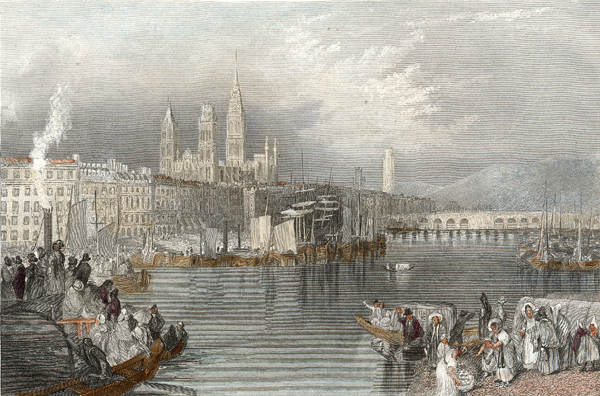
Rouen, from Meyer's Universum,
c. 1839
[21st. continued] Rouen is especially a commercial
town; its cotton manufactures give it the deserved name of the
Manchester of France. This traffic joined to the narrowness of
the streets fills the town with an indescribable bustle. Rouen
however has not an antiquated appearance from the river, for
on that side the old houses are masked by new and costly
mansions lining the quays.
I visited many other churches
here each of which has its peculiar interest attached to it
though altogether inferior to the three just mentioned. St
Godard and St Patrice should be visited on account of the
painted windows. The church of St Gervais is by no means to be
omitted. It is one of the oldest memorials of Christianity:
the chancel was erected about the 8th century over a crypt
which had been excavated some 5 or 6 centuries earlier for the
sake of private worship during the persecutions of the
faithful. The church of the Madeleine is a classical building
executed with boldness, simplicity and taste. I saw also the
old Hôtel du Bourg-theroulde in the court of which are some
curious bas reliefs on the subject of Henry 8th and Francis
1st.
I have said nothing in detail of the Cathedral,
St Ouen and St Maclou because books on books have been
published giving the minutest information concerning them. My
feelings on entering them were those of intense admiration.
The most incredible patience is everywhere visible in the
execution of elaborate details. The eye becomes dazzled and
even fatigued with the ornamental work and thus unconsciously
reproves the extreme floridity of style. Some of the porches
of these churches exemplify this. All the churches which I
have yet seen have an apsidal termination which adds much to
the effect. They have also a clean wide passage between the
back of the High Altar and the Lady Chapel. Everything is
however disfigured by the gaudy emblems of Romanist worship
and also by additions made at comparatively modern period,
such as screens and pulpits. One is reminded of Harlequin’s
hat on the head of Augustus.
The English architect
should visit the churches of Normandy to enlarge his mind and
give himself grand ideas of his noble art in a theoretical
point of view, but I doubt if he will gain much practical
benefit from it, for if we except perhaps the mouldings and
tracery, what details of a Norman church could be introduced
into a country where Commerce begets a calculating temperament
which destroys sudden and great emotions of the mind and where
Puritanism continually points out to us how the glory of
Heaven may be enjoyed at the slightest possible self-denial,
at the slightest possible expense.
22nd. Left Rouen
and went to Paris by railroad. A most picturesque line of road
with the Seine continually winding on the right or left.
Arrived in Paris after dark. Much embarrassed by my luggage.
Dined in the Palais Royal with a lady whom I met in the
train.
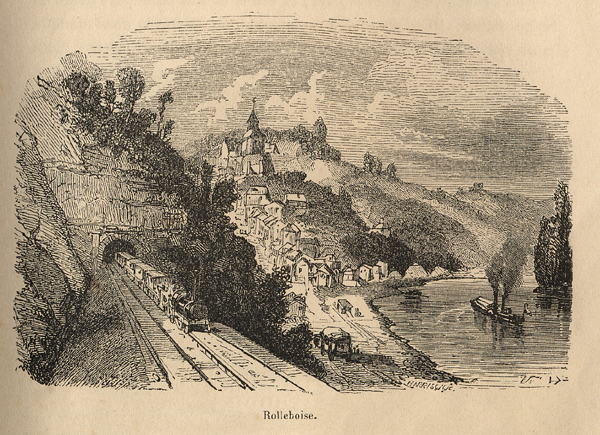
Rolleboise near Bonnières, halfway between Rouen
and Paris
Drawing
by Antoine-Léon Morel-Fatio in Voyage de Paris à la mer par
Rouen et le Havre (by Jules Janin), Paris n.d.
(1847)
The 2,646-metre-long railway tunnel, opened
for traffic in 1843, was the longest in the world. The train
in the picture is heading towards Paris.
[22nd. continued] Arrived in Paris after dark. Much
embarrassed by my luggage. Dined in the Palais Royal with a lady whom I met in the
train.
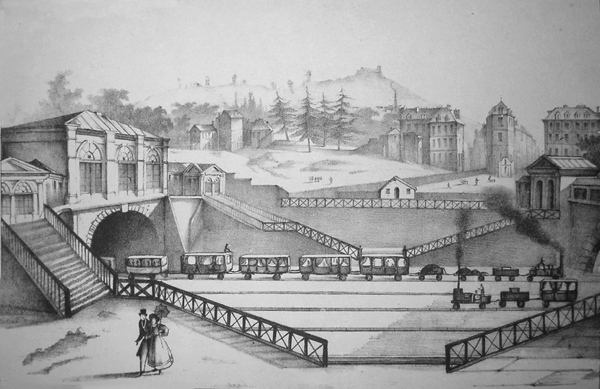
L'Embarcadère de la Place de l'Europe (or des
Batignolles)
Lithograph from the 1840s
This terminus, located some 200 metres north-west of the
present Gare Saint-Lazare, was inaugurated in 1837; it
served lines from Paris to Saint Germain, Versailles, and
Rouen.
23rd. Went into lodgings at No 7 Rue de
Tournon close to the Luxembourg.
24th. Wrote home.
Dined au Palais Royal for 1 Franc 80 centimes.
25th.
Felt ill. Dined near my lodgings for 2 frs 70
cents.
26th. Went to the Artesian well at Grenelle, a
great undertaking which required 7 years for completion, also
to the Abattoir, to the Champ de Mars. Dined at the Hôtel de
Lille, 4frs 50 cents.
27th. Went round the Cité and the
isle Louviers, to the frightful Morgue.
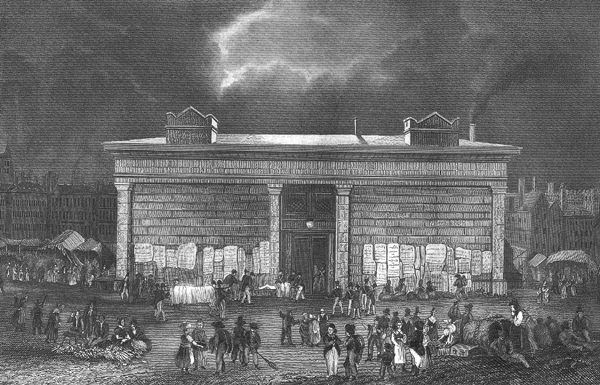
La Morgue, from Meyer's Universum,
c. 1844
[27th. continued] Dined at a traiteur’s
for 21 sous. Called on Lovett who was not to be seen. Went au
soir to the Café des Aveugles, a strange place.
28th. Went to the church St Roch
and the Madeleine, a glorious place. Dined at the Palais
Royal, 2 frs 20 cts.
29th. Went to the Jardin des
Plantes, Hôtel de Ville, Place Bastille. Dined at Rue Louvois,
1 fr. 30 cts.
30th. Called on the Rev. J. Lovett, 19
Rue Marboeuf, who gives me no hopes of my doing anything here
as a tutor; also on M. F. Monod, 90 Faubourg St Martin,
Protestant Pasteur Président; also on M. Forster, engraver, 4
Rue St Dominique D’Enfer. I had letters of introduction to all
these. Rue Louvois 1 fr. 30 cts.
May 1st. Called on the
Thatchers. Went with Mr Giles, Bisdy and Halket to Drakes, the
horse dealers, Boulevard de Madeleine, also to the Jockey
Club. Saw some fine fireworks au soir in the Tuileries. Rue
Louvois 1 fr 30 cts.
2nd. Arc d’Etoile, Bois de
Boulogne, Palais Royal 2 frs 10 cts.
3rd. Louvre, Opéra
Comique. P. R. 1fr. 70 cts.
4th. Dined at Palais Royal,
2 frs 10 cts.
5th. Went with Mr and Mrs Giles and an
American gentleman named Quinby to Versailles. The great and
small waters played, a very great sight. Dined at L’Hôtel
D’Europe, 3frs 50 cts.
6th. Went with Mr Giles and
another to the church St Etienne du Mont, the Panthéon and St
Sulpice. There is a fine view from the summit of the Panthéon,
Palais Royal 2 frs 10 cts.
7th. Went with the Giles to
the Champs Elysées to look for lodging. Dined in the Rue
Fauvart[?] in the English style, boiled beef, haunch of
mutton, half and half; strange company present. 2 frs 50
cts.
8th. Called on Madame Berthon née Violett, No 52
Rue de Notre Dame de Lorette, Quartier St Georges. Found that
her Father had died on Tuesday last and she was at Bordeaux.
Saw the two little girls, such pretty ones. Went over
Montmartre to breathe a little fresh air. Dined at the Rosbif
1.50.
[This was perhaps Au
Rosbif, an English restaurant shown in later guidebooks
as situated at 3 Rue de la Bourse, 2nd arr.]
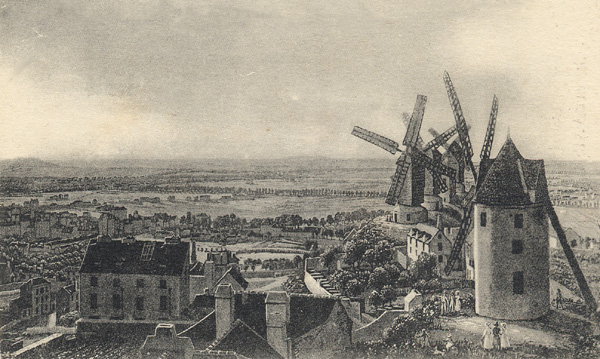
Montmartre, view westward, c.
1850
9th. Went over the Marine Gallery, a most
pleasing collection of models of ships. After that went with
Mr Giles, Harvoerd and another to the Hôtel de Cluny where
there is a most valuable collection of antique furniture of
every description, besides a fine chapel every way worthy of a
visit. Went also to Palais des Thermes. Palais Royal 2
frs.
Née Amerd[?] en Portland Square, alors Matthews,
Grove, Weston near Bath, ensuite Giles, Penton Cottage,
Andover.
11th. Went with Mr Giles to put his dog Jerry
in an infirmary in the Champs Elysées, then went with him and
Handfort to St Denis where there is a glorious Cathedral with
such painted glass, also fine vaults containing the cenotaphs
of the monarchs of France. Came back in a cart. Mr Giles and
his lady dined with me at the Trois Frères Provençaux in the
Palais Royal. We had Potage Printanier, then Rognons de mouton
au vin de Champagne, then Bifteck à la Sauce Tomate and pommes
de terre cuites, then poulet au cresson and a salade and
lastly une omelette soufflée. For this I paid as by agreement
15 francs. I had also some strawberries 3 frs, 1 bottle of
iced Champagne 7 frs, 1 Bottle Burgundy 6 frs, waiter 1½ fr.,
making altogether 32½ frs.
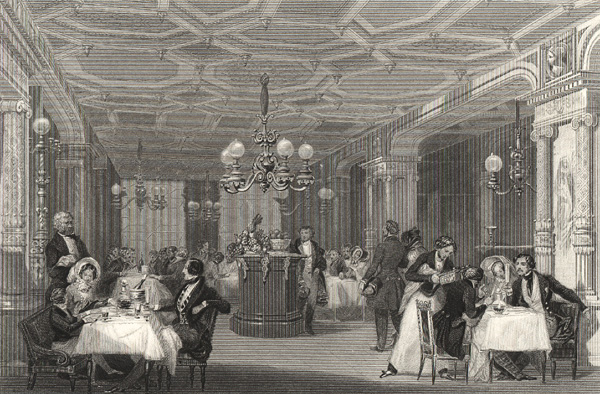
The
"Trois Frères Provençaux" restaurant in Palais Royal
Steel engraving by J.B.Allen after a picture by Eugène
Lami, c. 1840
[11th. continued] Had a letter from M.A.B. No
end of misery.
12th. Went to Mass alone at St Roch’s;
puis over the apartments at the Palais Royal, those
apartments, where such great events have been enacted,
and which are hung round with most interesting historical
paintings; then to the Picture Gallery of the Luxembourg; also
the Chamber of Peers; also the chambre à coucher of de
Medicis. Went to the Palais Royal Theatre, good acting but
broad equivoques. Rosbif 1 fr. 50 cts.
13th. Spent all
the morning with Mrs Giles, Giles having gone to St Cloud.
Wrote in her room a letter to M.A.B and posted it. Walked in
the Tuileries, one sou. Rosbif 1fr. 60 cts.
14th. Went
with Mr Giles to look for lodgings. Agreed to go to No 2 Rue
de l’Oratoire, Champs Elysées, belonging to a Madame Trallet
de St Arnaud. Dined with him at the Rosbif, 1 fr. 30
cts.
15th. Accompanied Mr Giles to his new apartments
and took tea with him. Walked home with Mr
Harvoerd.
16th. Paid my bill at 7 Rue de Tournon, 38
frs 40 cts. Strolled in the Luxembourg Gardens and talked to a
lady living in the Rue Neuve de l’Antin. Changed my quarters
to 2 Rue de l’Oratoire, Champs Elysées. Dined at the Rosbif, 1
fr. 30 cts, and then went to the Théâtre Français to see the
Bourgeois Gentilhomme. It was nicely played and fully came up
to my expectations. The Turkish ceremony was however absurd
and seemed to be considered so by the audience.
17th.
In all the horrors of having my room furnished. Went to the
Rue de Tournon and dined at the Rosbif, 1fr. 30
cts.
18th. Went to the chapel at Marboeuf. A long
sermon quantity-quality. Went to the Val de Grace chapel. Fine
ceiling.
19th. A very wet day. Went to the Rue de
Tournon. Heard a sermon in a church in the evening. The
preacher continued for 40 minutes extemporaneously with great
fluency and some grace.
Tuesday 21st. The payment of my
month’s rent at the Champs Elysées being from
today.
Sunday 25th [should be 26th]. Went with Mrs
Giles to mass at St Roch. It being the feast of the Pentecost
the mass was very fine. Called at the Rue de Tournon for
letters. Went to the Cathedral Notre Dame, three things worth
noticing: curious reliefs in the aisles of the chancel, a nice
font in a chapel on the North side of the chancel and the West
circular window very fine.
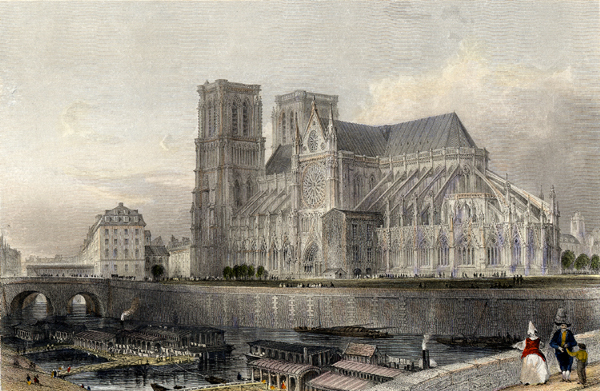
The Cathedral of Notre Dame
Steel engraving by J. H. LeKeux after a picture by T. Allom
from France Illustrated, 1840
[26th. continued] Went to St Roch again, then heard a
mass at the Madeleine. In the evening went to Notre Dame de Lorette with Mrs Giles, the singing was very good and the
sermon (in grace) was very superior. Had a letter from
home.
June 1st. Went to St Cloud a most enchanting
place on the borders of the Seine. Strolled about the Park but
did not go into the Palace. Dined at the Tête
Noire.
2nd. Attended service at the
Madeleine.
4th. Spent the greatest part of the day at
the Bibliothèque du Roi which is well worthy of attention. Saw
an extraordinary Zodiac brought from Denderah supposed to have
composed a ceiling, also a sun dial from Delos.
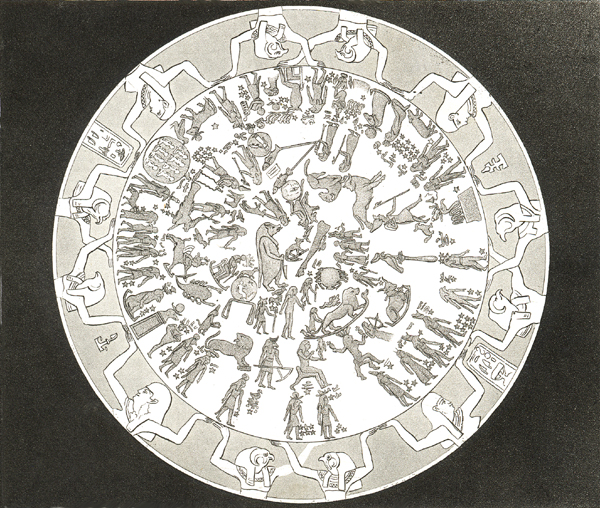
Le Zodiaque de Dendérah
Aquatint, published in Essai de Cosmographie, c. 1820
The zodiac is a bas-relief on a
sandstone slab
from the ceiling of the Hathor temple at Denderah in Upper
Egypt. The slab measures a little over 2.5 by 2.5 metres. It
was moved to Paris in 1821 to be installed in the Royal
Library in Rue Richelieu. It is now in the Louvre.
[4th. continued] Saw
magnificent cameos and intaglios, gemmed cups, suits of armour
belonging to Louis 13 and other kings. Valuable prints by
Albert Durer [Albrecht Dürer]. Autograph letters of Louis 14,
Duchesse de Vallière, Madame de Maintenon. The following is a
letter by Dr Franklin: "M. Franklin n’oublie jamais aucune
Partie où Me Helvétius doit être. Il croit même que
s’il étoit engagé d’aller à Paradis ce matin, il ferait
supplication d’être permis de rester sur terre jusqu’à une
heure & demie pour recevoir l’Embassade qu’elle a bien
voulu lui promettre en la rencontrant chez M. Turgot."
Went to the Odéon in the evening. Sat in the Stalles
d’Orchestre. Saw the Antigone of Sophocles performed. Was
amazed with joy at the way the tragedy was got up. The curtain
descended, more antique, the chorus was composed of 28 (in two
bodies of 14 each) and a choroegus. The translation was by
[Paul] Meurice & [Auguste] Vacquerie, the music by
Mendessholm [Mendelssohn]. The cast was as follows: Creon:
Bocage; Hemon: Milon; Tiresias: Bouvière; Chorège: Darcourt;
Messager or ’Άγγελος :
Achilles; Soldat: Quelus; Antigone: Bourbier; Ismene: Volet;
Eurydice: Dupont. Antigone’s acting was perfect, so was
Creon’s. Volet was a beautiful creature. The wail of the pipe
was introduced in the choruses with fine effect. Altogether it
was a grand exhibition.
7th. Went to the Bicêtre a
species of Union workhouse on a gigantic scale. It contains
about 4000 persons all men, chiefly old men. There are a large
number of lunatics (aliénés), also idiots. The inmates have
three meals a day; breakfast consisting of soup & bread,
lunch stewed fruits, and dinner, at four, soup bread &
wine. They are allowed to work at trades the produce of which
is sold in the city, and the money is brought back to the
individual who does not pay any portion of it to the
establishment. They have a change of shirts every 8 days,
stockings every 15. The water is raised from a gigantic well
of 200 feet in depth in large vessels by means of a wheel
worked by about 30 of the inmates in relays of 1 hour each,
they receiving pay for this work: thus a man working in 3
relays a day that is for 3 hours, receives about 6 sous. Many
who work at this are lunatics, idiots, and blind.
The
infirmary appropriated solely to the inmates is divided in two
wards, one surgical, the other medical. The countenances of
some of the sick resembled strongly those terrible but true
studies of Zurbarán. On Sunday the inmates are allowed to go
out a little way to see their friends. Two priests are
attached to the establishment and several physicians &
surgeons. The linen is mended at the Salpêtrière, a
neighbouring sister institution appropriated to females.
E Method in every branch of this wonderful charity seems carried
to perfection.
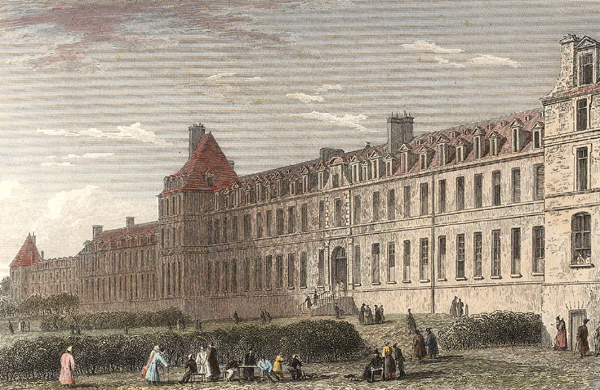
Hospice de Bicêtre
Drawing by
T. Nash,
engraved by Miss Byrne, c. 1830
"A visit to this hospital
cannot but be highly gratifying to every lover of humanity. …
The public are admitted on Thursdays and Sundays, from 12 till
4; but strangers are readily admitted on applying with
passport at the porter's lodge, … ." (Galignani's New Paris
Guide, Paris, 1846, p. 415)
[7th. continued]
Returning to Paris
I wandered through some old streets in the vicinity of the Rue
St Martin, La Rue des trois Maures, La Rue [Mathurin-]Régnier
&c. Posted a letter to M.B.
8th. Called on Mad.
Berthon who was out, also on the Thatchers with whom I sat for
two hours.
9th. Went to the shoemaker’s about my boots,
then to St Roch and saw a great procession, first the banner
of the Virgin, then young girls who have lately been
confirmed, then a very full military band and then the host
under a crimson canopy with four ostrich plumes. The
procession moved round the church 3 times and the service
ended by the band playing an air adapted from I Puritani. Went
to a Bal at the Chaumières, Boulevard Parnasse. Many handsome
young men were there, chiefly students, and many nice
women.
11th. Went with Mr Giles to Bercy in an omnibus,
then walked along the banks of the Seine through Carrières
& Charenton which are full of pretty villas with beautiful
gardens looking out on the river. Here is the confluence of
the Marne and the Seine. Crossed the bridge to l’Alfort where
there is a Veterinary school.
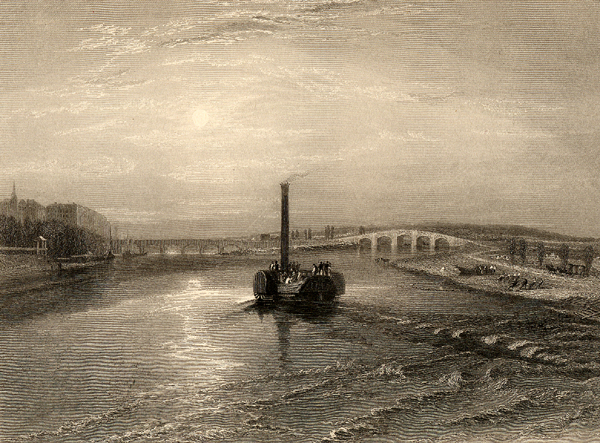
Confluence of the Seine and the Marne
Engraving by J. C. Armytage after a picture by J. M. W.
Turner, published in The Rivers of France, London,
1837
L’École nationale vétérinaire d’Alfort
was founded by Claude Bourgelat in 1766. It is the oldest
veterinary school still situated on its original site.
Walked to Vincennes, a most
interesting mass of buildings both as regards architecture and
historical associations. Returned to Paris in an omnibus. This
tour will well repay those who may undertake it.
12th.
Rode to the Rue de Tournon and got a letter from M.B. with
rather better news. Received a kind note from Mad. Berthon.
Walked from Rue de Tournon to the Salpêtrière, an enormous
hospital containing 6400 beds and killing 4½ oxen daily. Old
women are the inmates as well as others who are ill, blind or
lunatics. They boil their linen in huge vats for 14 hours
before they wash it. Thence rode to the Hôtel Dieu, the
largest hospital of Paris containing 800 sick. Everyone is
admitted here without reference to department or country. The
Bicêtre and Salpêtrière are limited to natives of the
department of the Seine.
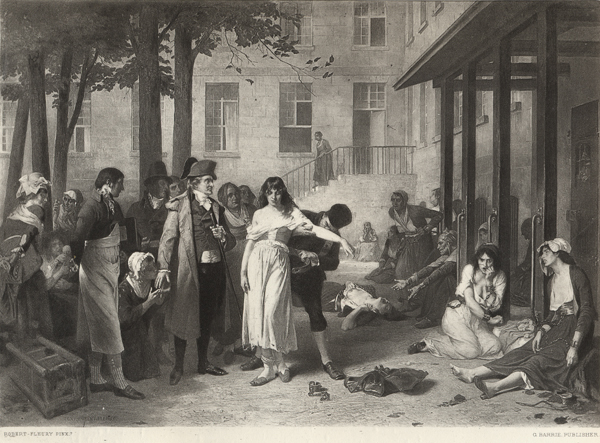
Dr
Pinel at the Salpêtrière
Drawing by Tony Robert-Fleury,
photogravure from c. 1870
[12th. continued] Looked into the Morgue and
saw a horrible sight. Three bodies were extended on the metal
beds in all the grim solemnity of death. One was a woman with
her face black by decomposition, her breasts & shoulders
livid and the lover extremities beginning to change. Another
was a man whose wan features and protruding ribs seemed to
hint that death agreeably interrupted his poverty. The
placidity of his countenance made me think that his spirit at
parting was well pleased at leaving the uncomfortable tenement
by which it had so long been embarrassed. The third was the
body of a powerful man who from his scarred body and battered
face must have been brutally assassinated. The other two had
been drowned.
13th. Took tea with Mad. Berthon née
Violett. She looks pale and harassed and, being in mourning on
account of her Father’s death, had a so much more haggard
appearance.
14th. Walked along the line of Barrières
extending from the Barrière de Neuilly to the Barrière de
Combat and visited the grand sewer of Montfaucon whence the
matière fécale of the metropolis is deposited and eventually
mixed with soil by hundreds of labourers to be sold as manure.
The effluvia were so great that I was ill during the rest of
the day.
16th. Went to Service at the Ambassador’s
chapel. One franc was demanded on entrance. The Service was
nicely performed. Bishop Luscombe preached.
17th. Paid
Mr Giles 40 frs, 20 for my room & 20 for 4 weeks’ board.
20th. Went to the Museums of the School of Medicine
and of Dupuytren. Saw in the first an examination in Chemistry
going on. The celebrated Orfila was one of the Examiners. He
has one of the finest heads I ever saw. The Dupuytren Museum
is remarkable for a very large number of models of syphilitic
cases the disgusting and sickening appearance of which can
only be surpassed by their exquisite formations.
26th.
Attended some lectures at the Sorbonne. The battle of
Pharsalia was well described by Mr Rosseeuw St Hilaire. Mr
Jules Simon discoursed learnedly on the existence &
attributes of a Deity while he played with his gold neck chain
and played with his black ringlets.
A
Dénouement.
27th. Took tea with Mad.
Berthon.
28th. Sorbonne again. Geruzez on French
eloquence. Called on Miss James, 9 Rue des
Saussayes.
29th. Went over a sort of boarding school
establishment at 57 Rue Clichy. I had some idea of going there
for a month, but did not like the place.
July 1st.
Left Mr Giles for No 11 Avenue Fortunée [rue Balzac].
2nd. Sorbonne.
3rd. Sorbonne A snarling letter
from home.
5th. Answered Ann’s letter. Went to
Courbevoie in a Diligence, thence walked to Suresnes and
returned by way of Puteaux. Dined at 7 and afterwards went to
the Salle Vincennes.
8th. Found that the Vacation had
commenced at the Sorbonne. Ordered some cloth boots at No 53
Rue St André des Arts for 13 frs. Bought Voltaire’s and
Catherine’s letters, Quintus Curtius and the Sibylline
Oracles, all for 15 sous in the Rue de Cluny. Asked the price
of a skull - 12 frs - didn’t buy it. Took Mrs Giles to the
Mabile ball. Giles went with Sir John Malcolm to Franconi’s.
Had a letter from E.B.: all right.
9th. Wrote to Anne.
Dined with Mrs Giles. Took tea with the Malcolms.
10th.
Took Mrs Giles to the Académie de Musique. Robert le Diable
was the piece. Scenery excessively good, but the orchestra had
not so powerful an effect as I anticipated from the number of
musicians.
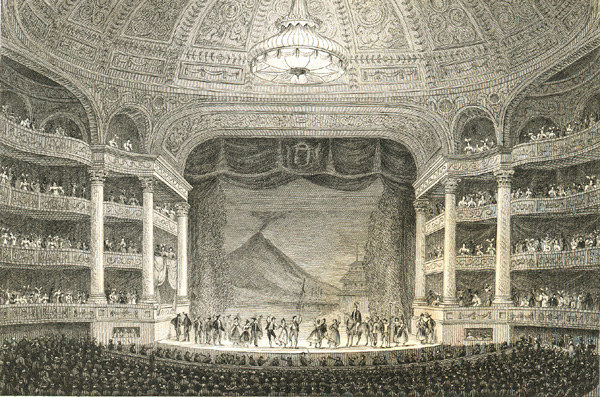
Académie royale de musique
Drawing by J. Nash, engraved by Fenner Sears & Co.
under the superintendence of Charles Heath, published in
Paris and its Environs Displayed in a Series of Picturesque
Views, London 1829
11th. Went over the chapel St Ferdinand, a
beautiful little gem erected to the memory of the Duc
D’Orléans. The reclining statue of the Duke is very good. His
countenance resembles much the portraits of our Saviour. There
is a most interesting picture of his death in a little room
behind the altar. Ascended the Arc de Triomphe and saw the sun
set. The Malcolms went also. Took the Miss Malcolms to a ball
(the little Tivoli) and had great fun.
12th Went with
Mrs Giles and Miss Malcolm to the statue and picture gallery
of the Louvre. Such pictures. Such a head of Jesus by
Guido.
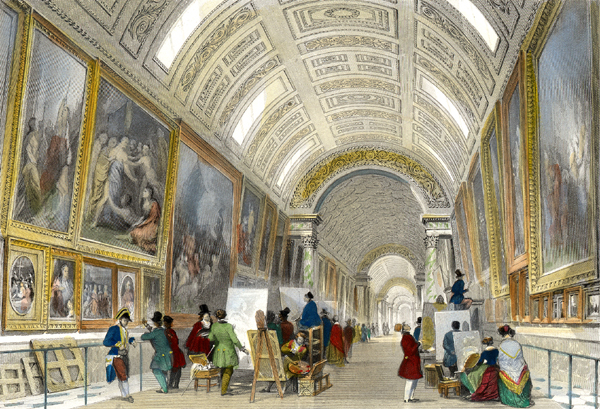
The Grand Gallery of the Louvre
Drawing by Thomas Allom,
engraved by J. B. Allen, c. 1840
16th. Received a letter from Mr H. Fyson with an
order for £10 on a M. Tourasse, 20 Rue St Fiacre, Boulevard
Poissonière. Moved to No 2 Rue de l’Oratoire.
17th.
Went in the evening to the Académie de Musique to see Der
Freischutz and Lady Henriette. The singing in the former was
third rate; the dancing in the latter excellent. Handed the
Miss Griveux into a carriage.
18th. Went to the
Mabilles. Had a letter from A. Fyson.
19th.
Received 252 frs from a Mr Tourasse, 20 Rue St Fiacre,
Boulevard Poissonière.
20th. Took a long walk by St
Denis, Montmorency, Enghien and back to St Denis by the
borders of the Seine. Had an old soldier as companion. All the
country very pretty.
22nd. Went to St Germain en Laye
with Mr and Mrs Giles by railroad. The only thing worthy of
notice is a terrace of very great length commanding a very
fine view of the valley of the Seine. James II kept a court
here for 12 years. Dined in the Palais Royal and took tea with
the Malcolms. Left them at 11 and walked all round town seeing
the Bude light in the Place du Carrousel.
25th. Went
with Mr and Mrs Giles to Fontainebleau, to Corbeil by railroad
and thence by Diligence, four hours altogether. Put up at a
clean inn called L’aigle noir. Went over the chateau which is
never inhabited. Walked over the grounds which are nicely
kept. Walked alone in the forest after moonrise.
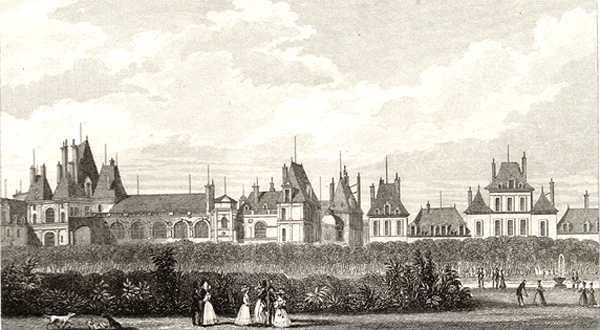
Fontainebleau vers le Jardin
Drawing by A. Pugin Junr, engraved by B. Winkles,
published in Paris and its Environs Displayed in a Series
of Picturesque Views, London 1829
26th.
Went in a sort of Whitechapel cart for a four hours’ ride
through the forest which abounds in extraordinary scenery.
Immense stones are piled up one above another so as to look
like artificial rock work done by giants. Some of the trees
are 4 and 500 years old. The oaks there are particularly well
grown. Dined and returned at nightfall.
27th. Went over
the Chamber of Deputies. The reception hall with the statues
of Bailly and Mirabeau is perfectly fine. These two statues
put one in mind of the wolf and the lamb.
28th. Went
with Sir John Malcolm and Plummer to bathe. Went with Mr and
Mrs Giles and the Malcolms to St Cloud to see the grandes Eaux
play. They please me much more than those of Versailles.
Walked home by moonlight.
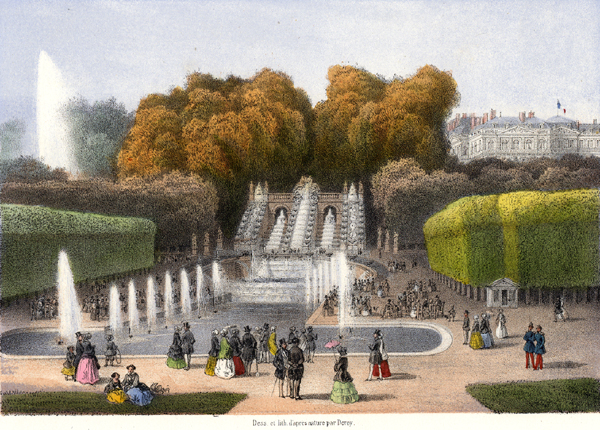
St
Cloud, Vue des Cascades, from France en Miniature, c.
1850
29th. The great day of the fête [Les Trois
Glorieuses of 1830], the 27th having only masses for the dead
and the 28th distribution to the poor. The banks of the Seine
were crowded with spectators from the Pont des Invalides to
the Pont Neuf to see jousts on the water, boat racing,
climbing up maypoles. The Champs Elysées were filled with
shows in front of which were stages on which danced most
grotesque masques.
At ¼ to 8 there was a grand concert in
front of the Tuileries. The king and royal family sat at a
window. The Marseillaise was played twice. After that came
some very magnificent fireworks and then the illuminations in
the Champs Elysées extending from the Place de la Concorde to
the triumphal Arch. The coup d’oeil was wonderful
– not to be
forgotten easily.
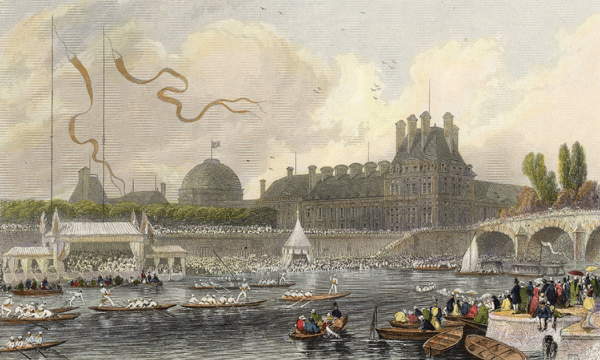
Tourney on the Seine during the July Fêtes
Engraving by J. T. Willimore after a picture by
Eugène Lami, c. 1840
August 4th. Went to a
concert with Mrs Giles at the Exposition. There were 400
musicians preceded over by Strauss. The effect was tremendous.
The overture of the Gazza Ladra was played as also of
Semiramis. La chasse du jeune Henri was very nicely
played.
7th. Rose early and went by railroad to
Corbeil, a very dull town. Breakfasted and strolled on the
heights overlooking the valley of the river. Returned by
steamer to the Place de Grève [de l’Hôtel de Ville]. The river
from Corbeil to Paris is sufficiently uninteresting and by no
means repays the traveller. Went after my return to Franconi’s
where I saw a horse leap over the backs of two
others.
9th. Rode on horseback in the Bois de Boulogne
with the Malcolms and Mr and Mrs Giles. Danced at the
Hamiltons au soir.
12th. Went with Mr Giles, Sir J.
Malcolm and Plummer first to the Marché du Vieux Linge, Rue du
Temple, then to Romainville, then by railroad to Meudon, an
exquisitely pretty place with a palace; thence walked to
Sèvres and St Cloud and returned by Diligence.
| 15th.
Took Mrs Giles to the Théâtre Français. The pieces were the
Phèdre of Racine and the Fourberies de Scapin. Rachel took the
part of Phèdre, Got of Scapin. Rachel was thin and weak having
lately given birth to a child. She used great action, more so
perhaps than would be pleasing to English. I hardly considered
her preferable to Bourbier in Antigone. She was extremely well
supported. The catastrophe related by the angelos "A peine
nous sortions &c." was not so good as I expected. Got got
through his Scapin admirably. |
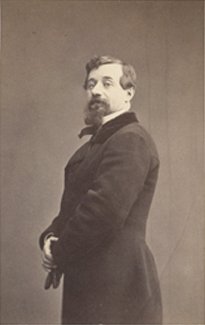 |
François Jules
Edmond Got
(1822-1901)
Photograph by Emile Bondonneau,
Photographie Valois, Paris
|
18th. Dined at the
Palais Royal with Mr and Mrs Giles and then got on the
Banquette of the Diligence to Havre where I arrived next
morning at 6.
19th. Set sail at 3 and got very sick in
no time. A man died on board from sea-sickness.
20th.
Arrived in Southampton at 8, breakfasted at the Vine. Had my
luggage passed and travelled to Bristol by the Celerity coach.
I could hardly imagine a succession of more beautiful scenery
than that between Southampton and Bristol.
|
